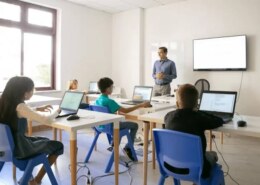In the last two decades, technology has transformed nearly every aspect of daily life, and education is no exception. Classrooms today look very different from those of the past, with chalkboards replaced by smartboards, notebooks replaced by tablets, and lectures often supplemented—or even replaced—by digital platforms. The impact of technology on modern classrooms is profound, offering both opportunities and challenges as educators and students navigate this evolving landscape.
1. Enhanced Learning Experience
Technology has revolutionized the way students learn. Interactive tools such as educational apps, online simulations, and multimedia presentations cater to different learning styles, making lessons more engaging and effective. Platforms like Khan Academy, Quizlet, and Duolingo provide personalized learning opportunities that were unimaginable a generation ago. With immediate feedback and adaptive learning paths, students can progress at their own pace, reinforcing strengths and addressing weaknesses.
2. Access to Information and Resources
With the internet, students have access to a wealth of knowledge beyond textbooks. Digital libraries, academic journals, videos, and global news sources are available at their fingertips. This accessibility not only supports research and homework but also encourages independent learning. Teachers can incorporate current events, global perspectives, and interdisciplinary materials to enrich classroom discussions.
3. Collaboration and Communication
Technology has also improved communication and collaboration among students and between students and teachers. Tools like Google Classroom, Microsoft Teams, and Zoom have made it easier to share documents, conduct group projects, and provide feedback. During the COVID-19 pandemic, these platforms became essential, enabling remote learning and maintaining educational continuity.
4. Preparation for the Future
Integrating technology in education prepares students for a digital future. Skills like coding, digital literacy, data analysis, and online communication are increasingly important in today’s job market. Classrooms equipped with the latest technology provide a training ground for these skills, helping students become confident and competent in a tech-driven world.
5. Challenges and Considerations
Despite the benefits, the use of technology in classrooms also presents challenges. Not all students have equal access to devices or reliable internet, leading to a “digital divide.” Additionally, excessive screen time can affect students’ physical and mental health. There are also concerns about data privacy, cybersecurity, and the overreliance on digital tools potentially diminishing critical thinking or interpersonal skills.
Conclusion
Technology has undoubtedly reshaped modern classrooms, offering enhanced learning experiences, broader access to information, and better preparation for the future. However, it is essential to implement these tools thoughtfully, ensuring that technology complements rather than replaces traditional teaching methods. By striking the right balance, educators can harness the power of technology to create more inclusive, dynamic, and effective learning environments.

